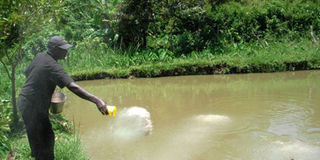Process your fish meal for bumper catch

A farmer feeds his fish with fish meal powder enriched with vitamins and proteins. Photos by Lominda Afedraru.
What you need to know:
The nutritional and physical characteristic of fish feeds is essential. For nutrition value, the feeds should have crude protein, lipids, niacin, vitamins and enzymes, writes Lominda Afedraru.
Aquaculture (fish farming) is a profitable venture in Uganda but is constrained by feeds, best feeding and breeding practices leading to inconsistent supply to consumers.
This too depends on the fish feed a farmer is providing to the fish depending on the fish species though most fish species in Uganda are fed on same feeds. The feed is a major expenditure for fish farmers and good fish feed management can reduce overall cost, improve fish farm environment and ensure healthy growth of fish stock.
Management
Fish feed management includes choosing the right feed, using a correct feeding method, calculating the feeding cost and ensuring the cost effectiveness of fish farm.
In a recent publication by Food and Agriculture Organisation (FAO) about the national aquaculture sector overview, it is stated that Uganda produces up to 15,000 tonnes of fish from aquaculture, including production from small-scale fish farmers, emerging commercial fish farmers and stocked community water reservoirs and minor lakes.
There are an estimated 20,000 ponds throughout the country with an average surface area of 500 square meter per pond.
Production ranges between 1,500 kilogrammes per hectare per year for subsistence farmers to 15,000 kilogrammes per hectare per year for emerging commercial fish farmers.
This expansion according to FAO in aquaculture has also resulted in the transformation of between 20 and 30 percent of the smallholder subsistence ponds into profitable small-scale production units through developments in management as well as scale of production.
It is estimated that there are 2 000 such farmers who own nearly 5, 000 ponds and the new entrants are mainly from middle and working class.
They have adopted improved production systems including inputs from technical experts for better planning and management.
Against this background Ivan Ssabwe, 24-year-old Makerere University graduate of marine nutrition, takes Seeds of Gold through the importance of fish farmers providing the right feed to their stock and below are excerpts.
Combination of fish feed
Ssabwe explains that in processing fish feed the farmer must consider aspects of food nutrition such as protein with 25 per cent content, fat, carbohydrates, vitamins and minerals which are essential nutrients for fish because they provides energy and builds the muscles.

Ivan Ssabwe explains how he makes the fish meal.
Vitamins and minerals are essential elements that can enhance natural resistance and feed conversion rate.
It is worthy that nutritional requirements of fish vary with different species, sizes, growth stages and feeding habits.
For example carnivorous fish require a higher intake of protein and fat than the omnivorous and herbivorous species, while marine fish require more protein and fat than freshwater fish do.
For this reason, fish feed should be specifically chosen to suit different species.
Types of fish meal
Ssabwe is particular about the fish feed being marketed by Kaffika Animal feeds and he explains the different feed types.
Floating pellet feed
These are dry pellets processed from mixture of moist concentrates of maize brand, soybean flour and grinded silverfish. There are also premixes of micro nutrients such as minerals, zinc, calcium and preservatives to keep it for a long period of time without getting wasted.
The ingredients are first cooked and made to stay under moisture before it is run through the machine to be extruded.
In the machine, there are dyes which will extrude the different sizes of pellets to feed different sizes of breeding fish.
It is important for the pellets to float for a period of one hour on water to give ample time for the fish to feed.
Powder feed
The powder fish feed is particularly processed for young fingerlings bred from the hatchery for onward breeding by farmers and the required size is fed to the fingerlings at the required time.
While feeding various fish species, farmers must ensure there is fish feeding points in the ponds and once the feed is dropped at this point the fish will all rush to that point to feed.
Marketing and prices
This particular fish feed is packaged in 10 kilogrammes costing Shs60,000 and 20 kilogrammes costing Shs100,000.
The feeds are available in farm input outlets across the country.
Ssabwe advices fish farmers to follow the right nutrient demand by fish species they are breeding at every stage for good growth.
Common fish species
He explains that production of fish seed and good taste across the country include Nile tilapia (Oreochromis niloticus) mainly breeding in river Nile, Lake Albert, Lake Victoria and Kyoga and several surrounding minor lakes and adjoining river systems.
Others are African catfish (Clarias gariepinus) found in all water bodies across the country, common carp (Cyprinus carpio) found mainly in Lake Bunyonyi in Western Uganda Tiger fish (hydrocynus), Lung fish (Protopterus), Pebbly fish (Angrara), electric fish and Brycinus nurse among others found in Lake Albert.
However, most farmers’ engaged in aquaculture are breeding tilapia and cat fish particularly in ponds and use of acquaponics technology.




